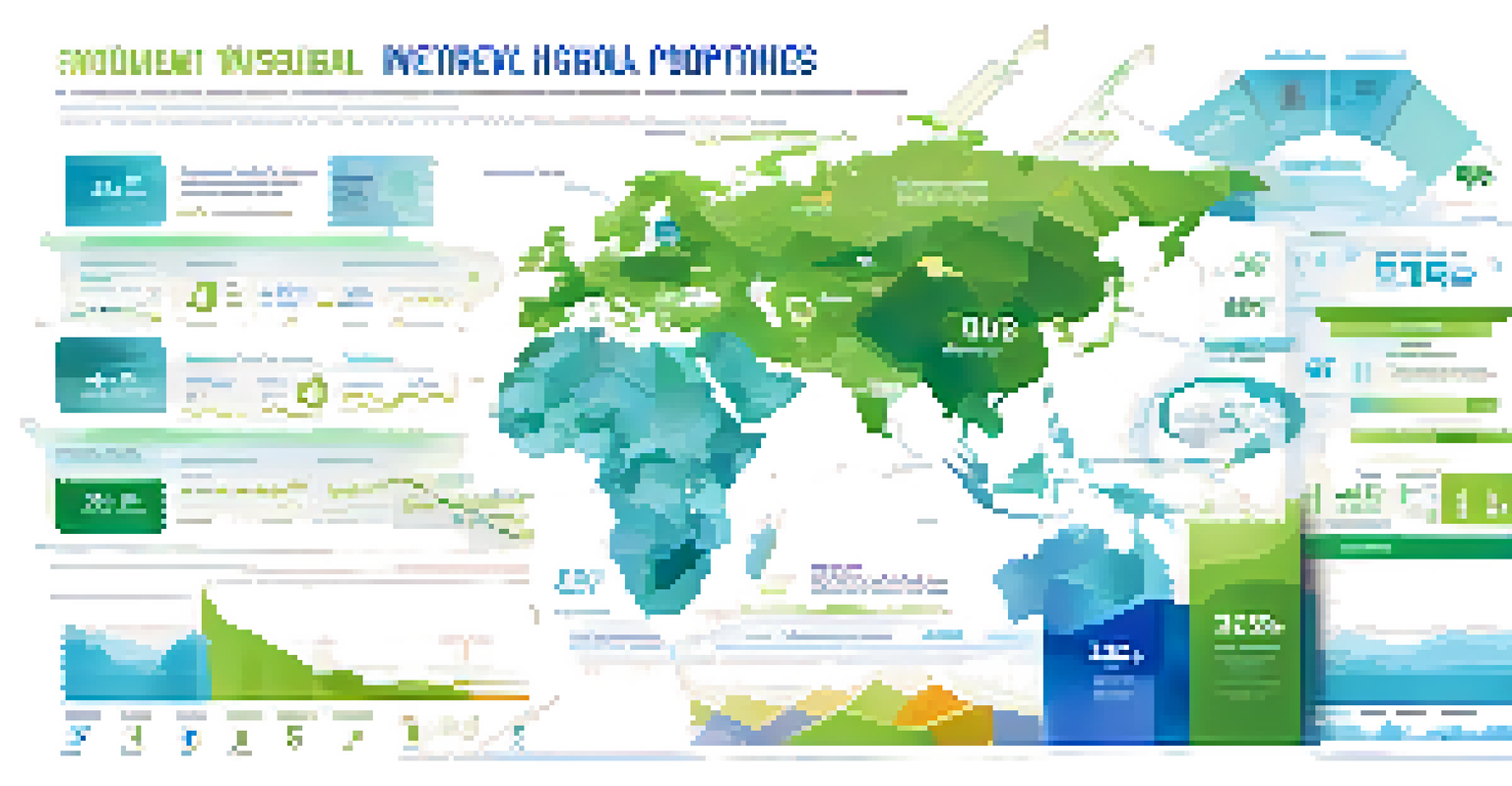Key Metrics for Evaluating Global Investment Opportunities

Understanding Market Potential and Demand Trends
When evaluating global investment opportunities, understanding market potential is crucial. This involves assessing the demand trends for products and services in the target region. For instance, a growing middle class in emerging markets often indicates higher consumer spending, making it ripe for investment.
In the world of investing, what you don't know can hurt you.
By analyzing historical data and current trends, investors can forecast future growth. Tools like market research reports and consumer surveys can provide valuable insights into what products might succeed. For example, if there’s a rising interest in sustainable products, investing in green technologies could be a smart move.
Ultimately, gauging market potential helps investors align their strategies with consumer needs, paving the way for long-term success. Recognizing shifts in demand can lead to timely investments that capitalize on emerging opportunities.
Evaluating Political and Economic Stability
Political and economic stability is a key metric in assessing global investment opportunities. Investors must consider factors such as government policies, regulatory frameworks, and economic indicators like GDP growth rates. A stable political environment reduces risks and enhances investor confidence.

For instance, countries with fluctuating governments may pose higher risks due to sudden policy changes. Investors should look at how a government’s stance on foreign investments may affect their potential returns. Research into past political events can provide valuable lessons on stability.
Understand Market Demand Trends
Evaluating market potential involves analyzing consumer demand trends to identify promising investment opportunities.
Monitoring economic indicators also helps in anticipating future performance. A country experiencing steady economic growth is typically more appealing than one riddled with inflation or recession. Understanding these dynamics can significantly influence investment decisions.
Assessing Currency Risk and Exchange Rates
Currency risk is an often-overlooked factor in global investments. Fluctuations in exchange rates can dramatically impact returns, especially if profits are repatriated back to the investor's home currency. Therefore, understanding the currency landscape of the target market is essential.
The best investment you can make is in yourself. The more you learn, the more you earn.
For example, a strong domestic currency may diminish returns when converting profits from a weaker foreign currency. Investors should utilize tools like hedging strategies or currency options to mitigate this risk. This proactive approach can safeguard investments from currency volatility.
Additionally, monitoring economic news and trends can help investors anticipate shifts in currency strength. By staying informed, investors can make timely decisions that protect their investments from unforeseen currency risks.
Analyzing Competitive Landscape and Market Entry Barriers
Understanding the competitive landscape is vital for any investment strategy. Analyzing existing competitors and their market share can reveal potential challenges and opportunities. For instance, entering a market dominated by established players may require innovative strategies or unique value propositions.
Market entry barriers such as high startup costs, regulatory requirements, or strong local preferences can also influence investment decisions. Investors should evaluate these barriers to determine if they can feasibly enter and succeed in the market. A thorough SWOT analysis (Strengths, Weaknesses, Opportunities, Threats) can be beneficial here.
Assess Political and Economic Stability
Political and economic stability are crucial factors that influence investor confidence and risk assessment in global markets.
Ultimately, a deep dive into the competitive environment informs strategic decisions, helping investors position themselves effectively. By understanding who they’re up against, investors can craft strategies that maximize their chances of success.
Evaluating Infrastructure and Logistics Capabilities
Infrastructure plays a critical role in determining the feasibility of global investments. Access to reliable transportation, communication networks, and utilities can significantly impact operational efficiency. For example, poor infrastructure in a region can hinder supply chain management and increase costs.
Investors should assess the existing infrastructure and any planned developments in the region. Regions with ongoing investments in infrastructure often indicate a commitment to economic growth, making them attractive for investment. A well-connected area can lead to smoother operations and better customer access.
Furthermore, understanding logistics capabilities can help investors gauge delivery times and operational costs. Efficient logistics can enhance customer satisfaction and contribute to overall business success. Thus, evaluating infrastructure is crucial for making informed investment choices.
Examining Regulatory Environment and Compliance Requirements
The regulatory environment is a fundamental metric for global investments. Understanding the laws and regulations governing foreign investment can help avoid legal pitfalls. Countries with transparent and investor-friendly regulations are generally more appealing.
For example, some countries may impose stringent compliance requirements, which can increase operational costs and complexity. Investors should conduct thorough due diligence to understand these regulations. Consulting local legal experts can provide clarity on the compliance landscape.
Leverage Technology for Insights
Using technology and data analytics allows investors to make informed decisions by uncovering market trends and consumer behaviors.
Moreover, being proactive in understanding regulatory changes can help investors adapt quickly. Staying informed about policy changes allows for timely adjustments to investment strategies, ensuring compliance and minimizing risks.
Identifying Social and Cultural Factors Impacting Investment
Social and cultural factors are often overlooked but can significantly influence investment success. Understanding local customs, consumer behaviors, and societal norms can shape marketing strategies and product offerings. For instance, what works in one culture may not resonate in another, necessitating tailored approaches.
Investors should engage with local communities and conduct market studies to gather insights into cultural preferences. This understanding can guide branding and customer engagement strategies, enhancing the likelihood of acceptance in the market. A culturally sensitive approach can foster trust and loyalty among consumers.

Additionally, being aware of social issues, such as income inequality or environmental concerns, can guide ethical investment decisions. Aligning investments with local values not only supports community development but can also enhance brand reputation and loyalty.
Utilizing Technology and Data Analytics for Insights
In today’s digital age, leveraging technology and data analytics is essential for evaluating global investment opportunities. Advanced analytics tools can provide insights into market trends, consumer behaviors, and competitive landscapes. This data-driven approach enables investors to make informed decisions based on real-time information.
For example, using big data analytics can help identify emerging markets and consumer preferences that may not be immediately apparent. Social media trends and online consumer behavior can offer valuable insights into what products are gaining traction. This technology can be a game changer for strategic investment planning.
Furthermore, incorporating technology into operations can enhance efficiency and reduce costs. From supply chain management to customer engagement, technology can streamline processes and improve overall performance. Thus, investing in technology not only informs decision-making but also boosts operational effectiveness.